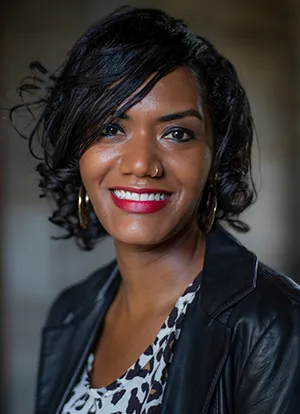Q&A with Intercultural Center Director Imaani El-Burki

Imaani El-Burki looks back on her previous stop at Swarthmore as the pivotal moment of her professional life.
As a Ph.D candidate at Drexel University, El-Burki interned with the Black Cultural Center (BCC) in 2008. She learned from then-director Timothy Sams how identity centers work and what it means to offer co-curricular support to students.
“He was really purposeful about connecting the dots between the academic components of the institution and also just the overall shaping of the students who came in,” says El-Burki. “And he brought me along for a lot of that. So my impression of the College was an awesome one, and set the tone for who I became in the future.”
She applied those lessons for two years as director of the Project Blueprint program and—now back at Swarthmore after seven years of studying and teaching—continues to draw upon them as a new assistant dean and director of the Intercultural Center (IC).
In the midst of a hectic first few weeks of the fall semester, El-Burki sat down to discuss the job's appeal, her vision for the IC, and what she views as her greatest challenge.
What appealed to you about this role?
I remember reading the job description and checking off all the boxes: “I can do this, I know this.” And I spoke with [Sams], who really encouraged me to apply. But the biggest thing was probably just knowing the community. In particular, the level of support you get here. One of the things that makes a job worth doing is knowing that others who are with you are looking in the same direction. So I saw a lot of opportunities for collaboration, people who want to accomplish the same larger goals that I envision our center accomplishing in support of the students. The timing felt perfect, too. This whole strategic direction of inclusive excellence gives me the feeling that this is where I need to be.
What is your vision for the IC?
One thing I know well about Swarthmore is that my vision should be rooted in a shared vision. So it’s difficult for me to say, “This is what I envision for the space.” I’m very much still learning the desires of the students we support in this community. What I can write down in pen is that I want this place to be what it has been for folks. When I accepted the job and changed my status on LinkedIn, I had alums contacting me, telling me how much they loved the IC and what it had meant to them. The main thing I’m tied to is giving the current students that same attachment—this kind of positive narrative and nostalgic memories of good things.
What’s a typical day for you, if there is such a thing?
Well it never goes slowly, I can say that. We get here and hit the ground running, with a variety of responsibilities as the IC team. One of the main things is figuring out what the student groups we support need at any given time, such as Latinx Heritage Month, to reach their programming goals. Then there are times where we step back as the [Inclusive Excellence and Community Development] team and share our vision and goals and mission for each center and collectively. I also engage on a weekly basis in the Dean’s meetings and figure out what types of academic support we can provide to students. And then we do the basic stuff of making sure that the IC is available for people to have meetings and events. It’s a lot of hats and a lot of things to do, but luckily there’s a lot of synergy and things seem to overlap in a way that isn’t overwhelming.
What do you see as your greatest challenge/opportunity in this position?
We have to be very mindful about approaching and engaging and responding appropriately to the needs of our students. They’re ever-changing. Keeping the lines of communication open and continuously building trust is a challenge that we can meet and that we’ll always need to meet, to be very clear about the type of students who tend to be attracted to this institution and responding appropriately to their needs.
What are some of your favorite aspects of the job thus far?
OK, so one of my favorite things is there’s always a lot of food around. So that’s a cool thing. We’re always making sure that there’s food available. And the relaxed nature. Sometimes, in the Quaker tradition, folks will take it easy or have a moment of quiet. I like that. I like the culture of support. When you have a lot going on, someone’s always willing to help you out a little bit. And the other cool thing is everyone seems to recognize “Swattie time,” where you have 10 minutes to kind of wiggle your way into the meeting. Everyone’s really understanding of our schedules.
What’s something interesting about you that people might not know?
Aww, man, I don’t know. I’m such an open book, honestly. I did a vegan/vegetarian fast recently, but word got around on that pretty quickly [laughs]. But a huge part of my life is being a mom. I have a 10-year-old daughter who’s in a Quaker school now. That’s another thing that connects me to Swarthmore students. Since my daughter is in a really similar environment, I can make that connection and get a fuller sense of who she’s probably on her way to becoming. So that’s heartwarming to me.
To learn about Swarthmore’s commitment to access and inclusion, visit lifechanging.swarthmore.edu.



